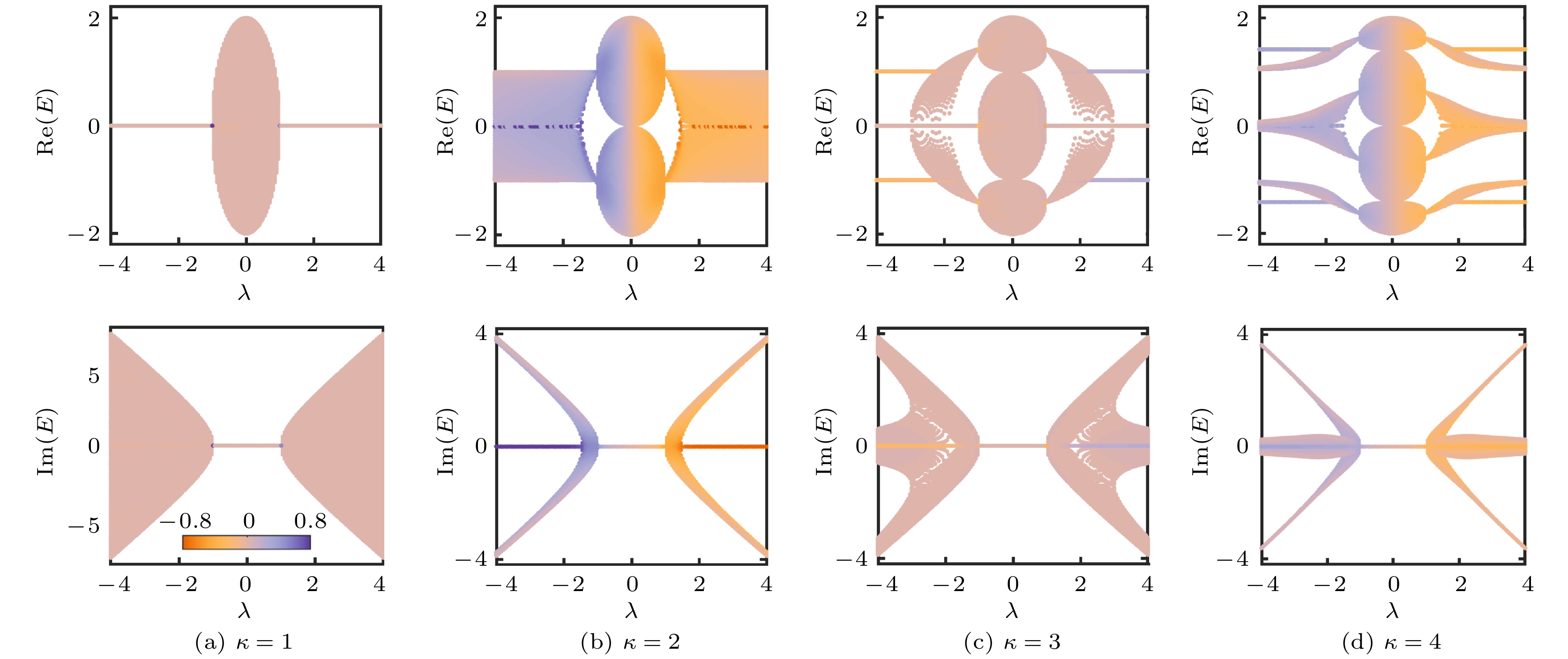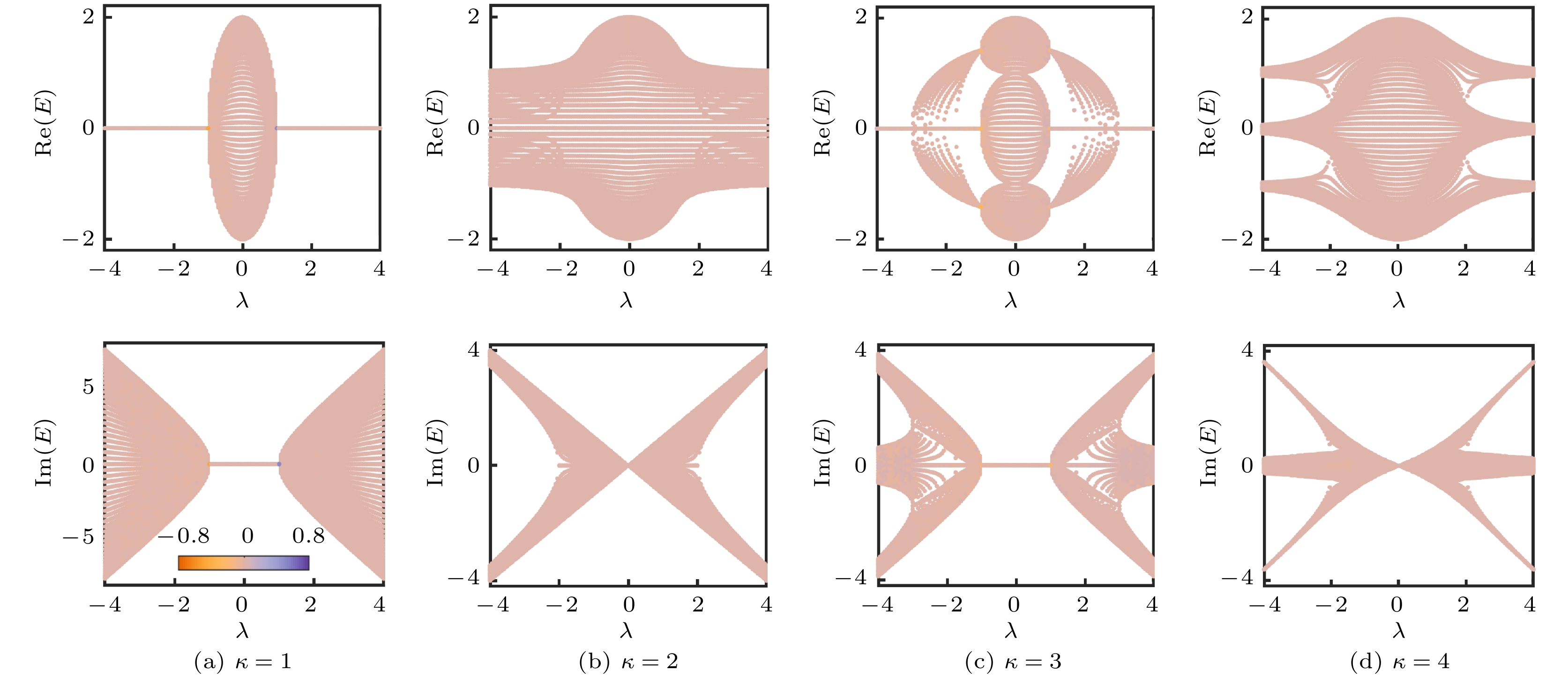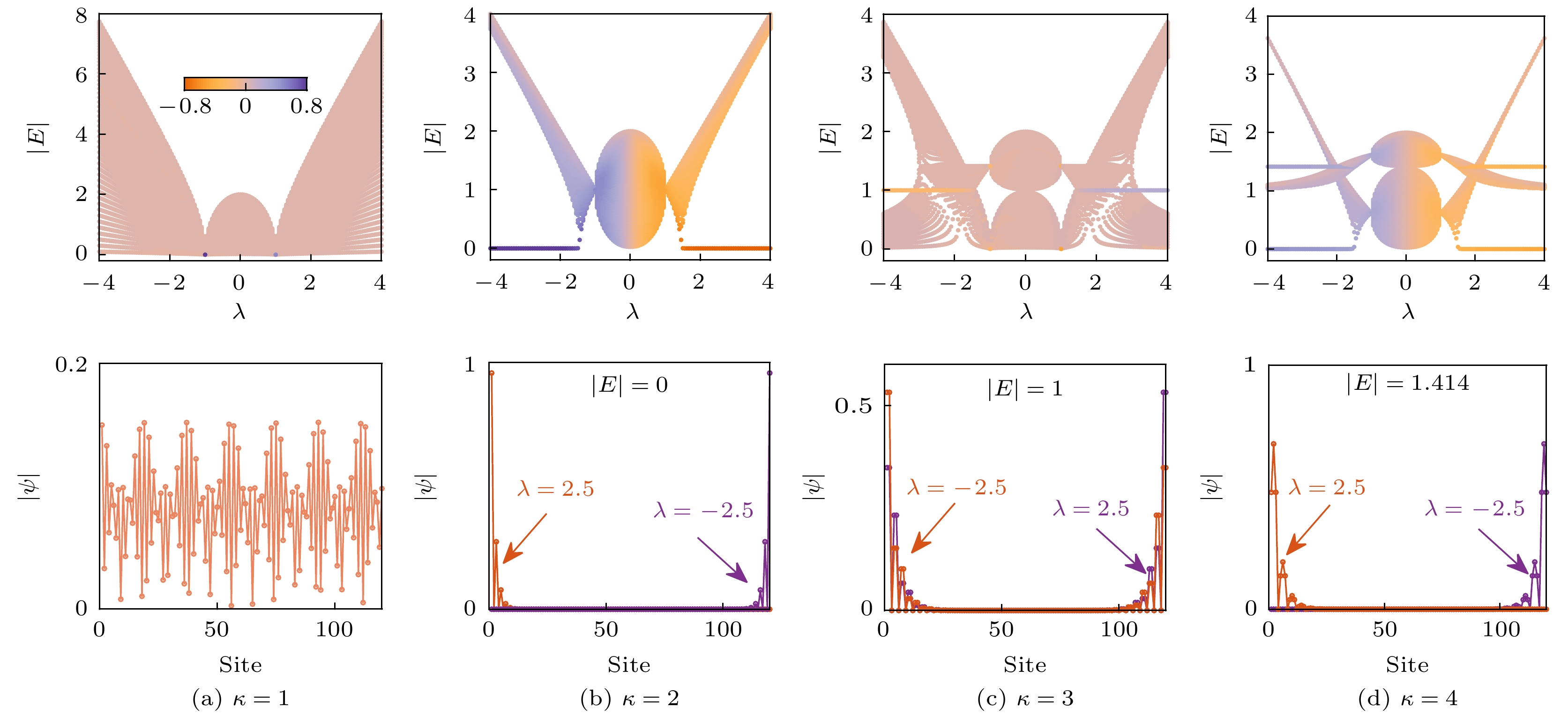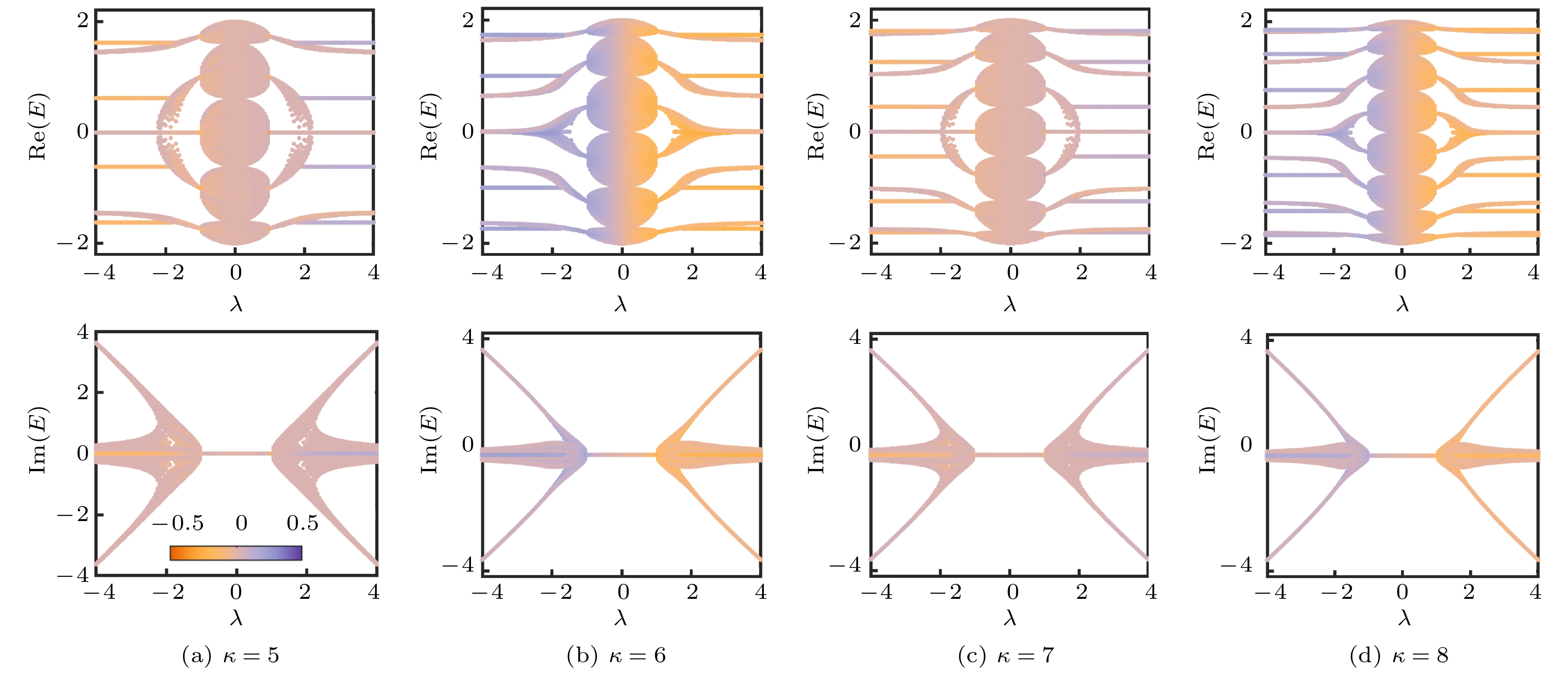-
Non-Hermitian systems have attracted much attention during the past few years, both theoretically and experimentally. The existence of non-Hermiticity can induce multiple exotic phenomena that cannot be observed in Hermitian systems. In this work, we introduce a new non-Hermitian system called the non-Hermitian mosaic dimerized lattice. Unlike the regular nonreciprocal lattices where asymmetric hoppings are imposed on every hopping term, here in the mosaic dimerized lattices the staggered asymmetric hoppings are only added to the nearest-neighboring hopping terms with equally spaced sites. By investigating the energy spectra, the non-Hermitian skin effect (NHSE), and the topological phases in such lattice models, we find that the period of the mosaic asymmetric hopping can influence the system’s properties significantly. For a system with real system parameters, we find that as the strength of asymmetric hopping increases, the energy spectra of the system under open boundary conditions will undergo a real-imaginary or real-complex transition. As to the NHSE, we find that when the period is odd, there appears no NHSE in the system and the spectra under open boundary conditions (OBCs) and periodic boundary conditions (PBCs) are the same (except for the topological edge modes under OBCs). If the period of the mosaic asymmetric hopping is even, the NHSE will emerge and the spectra under different boundary conditions exhibit distinctive structures. The PBC spectra form loop structures, indicating the existence of point gaps that are absent in the spectra under OBCs. The point gap in the PBC spectrum is shown to be the topological origin of the NHSE under OBCs, which also explains the NHSE in our mosaic dimerized lattices. To distinguish whether the bulk states of the system under OBCs are shifted to the left or right end of the one-dimensional lattice due to the NHSE, we define a new variable called the directional inverse participation ratio (dIPR). The positive dIPR indicates that the state is localized at the right end while the negative dIPR corresponds to the states localized at the left end of the one-dimensional lattice. We further study the topological zero-energy edge modes and characterize them by calculating the Berry phases based on the generalized Bloch Hamiltonian method. In addition, we also find that the topological edge modes with nonzero but constant energy can exist in the system. Our work provides a new non-Hermitian lattice model and unveils the exotic effect of mosaic asymmetric hopping on the properties of non-Hermitian systems.
-
Keywords:
- non-Hermitian systems /
- mosaic asymmetric hopping /
- non-Hermitian skin effect /
- topological zero-energy edge modes
[1] Cao H and Wiersig J 2015 Rev. Mod. Phys. 87 61
 Google Scholar
Google Scholar
[2] Konotop V V, Yang J, Zezyulin D A 2016 Rev. Mod. Phys. 88 035002
 Google Scholar
Google Scholar
[3] El-Ganainy R, Makris K G, Khajavikhan M, Musslimani Z H, Rotter S, Christodoulides D N 2018 Nat. Phys. 14 11
 Google Scholar
Google Scholar
[4] Ashida Y, Gong Z, Ueda M 2020 Adv. Phys. 69 3
[5] Bergholtz E J, Budich J C, Kunst F K 2021 Rev. Mod. Phys. 93 015005
 Google Scholar
Google Scholar
[6] Makris K G, El-Ganainy R, Christodoulides D N, Musslimani Z H 2008 Phys. Rev. Lett. 100 103904
 Google Scholar
Google Scholar
[7] Klaiman S, Günther U, Moiseyev N 2008 Phys. Rev. Lett. 101 080402
 Google Scholar
Google Scholar
[8] Guo A, Salamo G J, Duchesne D, Morandotti R, Volatier-Ravat M, Aimez V, Siviloglou G A, Christodoulides D N 2009 Phys. Rev. Lett. 103 093902
 Google Scholar
Google Scholar
[9] Rüter C E, Makris K G, El-Ganainy R, Christodoulides D N, Segev M, Kip D 2010 Nat. Phys. 6 192
 Google Scholar
Google Scholar
[10] Regensburger A, Bersch C, Miri M A, Onishchukov G, Christodoulides D N, Peschel U 2012 Nature 488 167
 Google Scholar
Google Scholar
[11] Feng L, Xu Y L, Fegadolli W S, Lu M H, Oliveira J E B, Almeida V R, Chen Y F, Scherer A 2013 Nat. Mater. 12 108
 Google Scholar
Google Scholar
[12] Peng B, Özdemir S K, Lei F, Monifi F, Gianfreda M, Long G L, Fan S, Nori F, Bender C M, Yang L 2014 Nat. Phys. 10 394
 Google Scholar
Google Scholar
[13] Wiersig J 2014 Phys. Rev. Lett. 112 203901
 Google Scholar
Google Scholar
[14] Hodaei H, Hassan A U, Wittek S, Garcia-Gracia H, El-Ganainy R, Christodoulides D N, Khajavikhan M 2017 Nature 548 187
 Google Scholar
Google Scholar
[15] Chen W, Özdemir S K, Zhao G, Wiersig J, Yang L 2017 Nature 548 192
 Google Scholar
Google Scholar
[16] Brody D C, Graefe E M 2012 Phys. Rev. Lett. 109 230405
 Google Scholar
Google Scholar
[17] Lee T E, Chan C K 2014 Phys. Rev. X 4 041001
[18] Li J, Harder A K, Liu J, de Melo L, Joglekar Y N, Luo L 2019 Nat. Commun. 10 855
 Google Scholar
Google Scholar
[19] Kawabata K, Ashida Y, Ueda M 2017 Phys. Rev. Lett. 119 190401
 Google Scholar
Google Scholar
[20] Hamazaki R, Kawabata K, Ueda M 2019 Phys. Rev. Lett. 123 090603
 Google Scholar
Google Scholar
[21] Xiao L, Wang K, Zhan X, Bian Z, Kawabata K, Ueda M, Yi W, Xue P 2019 Phys. Rev. Lett. 123 230401
 Google Scholar
Google Scholar
[22] Wu Y, Liu W, Geng J, Song X, Ye X, Duan C K, Rong X, Du J 2019 Science 364 878
 Google Scholar
Google Scholar
[23] Yamamoto K, Nakagawa M, Adachi K, Takasan K, Ueda M, Kawakami N 2019 Phys. Rev. Lett. 123 123601
 Google Scholar
Google Scholar
[24] Naghiloo M, Abbasi N, Joglekar Y N, Murch K W 2019 Nat. Phys. 15 1232
 Google Scholar
Google Scholar
[25] Matsumoto N, Kawabata K, Ashida Y, Furukawa S, Ueda M 2020 Phys. Rev. Lett. 125 260601
 Google Scholar
Google Scholar
[26] Gong Z, Ashida Y, Kawabata K, Takasan K, Higashikawa S, Ueda M 2018 Phys. Rev. X 8 031079
[27] Shen R, Lee C H 2021 arXiv: 2107.03414
[28] Zeng Q B, Lü R 2022 Phys. Rev. A 105 042211
 Google Scholar
Google Scholar
[29] Bender C M, Boettcher S 1998 Phys. Rev. Lett. 80 5243
 Google Scholar
Google Scholar
[30] Bender C M, Brody D C, Jones H F 2002 Phys. Rev. Lett. 89 270401
 Google Scholar
Google Scholar
[31] Bender C M 2007 Rep. Prog. Phys. 70 947
 Google Scholar
Google Scholar
[32] Mostafazadeh A 2002 J. Math. Phys. 43 205
 Google Scholar
Google Scholar
[33] Mostafazadeh A 2010 Int. J. Geom. Meth. Mod. Phys. 7 1191
 Google Scholar
Google Scholar
[34] Zeng Q B, Yang Y B, Lü R 2020 Phys. Rev. B 101 125418
 Google Scholar
Google Scholar
[35] Kawabata K, Sato M 2020 Phys. Rev. Res. 2 033391
 Google Scholar
Google Scholar
[36] Lee T E 2016 Phys. Rev. Lett. 116 133903
 Google Scholar
Google Scholar
[37] Lieu S 2018 Phys. Rev. B 97 045106
 Google Scholar
Google Scholar
[38] Yin C, Jiang H, Li L, Lü R, Chen S. 2018 Phys. Rev. A 97 052115
 Google Scholar
Google Scholar
[39] Hatano N, Nelson D R 1996 Phys. Rev. Lett. 77 570
 Google Scholar
Google Scholar
[40] Yao S, Wang Z 2018 Phys. Rev. Lett. 121 086803
 Google Scholar
Google Scholar
[41] Yao S, Song F, Wang Z, 2018 Phys. Rev. Lett. 121 136802
 Google Scholar
Google Scholar
[42] Xiong Y 2018 J. Phys. Commun. 2 035043
 Google Scholar
Google Scholar
[43] Budich J C, Bergholtz E J 2020 Phys. Rev. Lett. 125 180403
 Google Scholar
Google Scholar
[44] Koch F, Budich J C 2022 Phys. Rev. Res. 4 013113
 Google Scholar
Google Scholar
[45] Kunst F K, Edvardsson E, Budich J C, Bergholtz E J 2018 Phys. Rev. Lett. 121 026808
 Google Scholar
Google Scholar
[46] Jin L, Song Z 2019 Phys. Rev. B 99 081103(R
[47] Yokomizo K, Murakami S 2019 Phys. Rev. Lett. 123 066404
 Google Scholar
Google Scholar
[48] Herviou L, Bardarson H H, Regnault N 2019 Phys. Rev. A 99 052118
 Google Scholar
Google Scholar
[49] Yang Z, Zhang K, Fang C, Hu J 2020 Phys. Rev. Lett. 125 226402
 Google Scholar
Google Scholar
[50] Zirnstein H G, Refael G, Rosenow B 2021 Phys. Rev. Lett. 126 216407
 Google Scholar
Google Scholar
[51] Zhang Z Q, Liu H, Liu H, Jiang H, Xie X C 2022 arXiv: 2201.01577
[52] Borgnia D S, Kruchkov A J, Slager R J 2020 Phys. Rev. Lett. 124 056802
 Google Scholar
Google Scholar
[53] Okuma N, Kawabata K, Shiozaki K, Sato M 2020 Phys. Rev. Lett. 124 086801
 Google Scholar
Google Scholar
[54] Zhang K, Yang Z, Fang C 2020 Phys. Rev. Lett. 125 126402
 Google Scholar
Google Scholar
[55] Shnerb N M, Nelson D R 1998 Phys. Rev. Lett. 80 5172
 Google Scholar
Google Scholar
[56] Jiang H, Lang L J, Yang C, Zhu S L, Chen S 2019 Phys. Rev. B 100 054301
 Google Scholar
Google Scholar
[57] Zeng Q B, Xu Y 2020 Phys. Rev. Res. 2 033052
 Google Scholar
Google Scholar
[58] Liu Y, Wang Y, Liu X J, Zhou Q, Chen S 2021 Phys. Rev. B 103 014203
 Google Scholar
Google Scholar
[59] Liu Y, Zhou Q, Chen S 2021 Phys. Rev. B 104 024201
[60] Wang Y, Xia X, Zhang L, Yao H, Chen S, You J, Zhou Q, Liu X J 2020 Phys. Rev. Lett. 125 196604
 Google Scholar
Google Scholar
[61] Zeng Q B, Lü R, You L 2021 Europhys. Lett. 135 17003
 Google Scholar
Google Scholar
[62] Zeng Q B, Lü R 2021 Phys. Rev. B 104 064203
-
图 1 具有镶嵌型非对称跃迁的一维非厄米二聚化晶格示意图. 第sκ个格点和第sκ+1格点之间的跃迁振幅是不对称的, 为
$ t \pm {( - 1)^j}\lambda $ Figure 1. Schematic of the one-dimensional non-Hermitian mosaic dimerized lattice with asymmetric hopping. The backward and forwardward hopping amplitudes between the sκ-th and sκ+1-th sites are
$ t \pm {( - 1)^j}\lambda $ , which are asymmetric.图 2 具有不同镶嵌型调制的一维非厄米二聚化晶格模型在开边界条件下的本征能谱. 上半部分为能谱实部, 下半部分为能谱虚部; 图中的颜色代表该能量对应的本征态的dIPR值; 系统大小为
$ L = 120 $ Figure 2. The eigenenergy spectra of the 1D non-Hermitian dimerized lattices with different mosaic modulations. The upper panel shows the real parts of the spectra while the lower panel shows the imaginary parts, the colorbar indicates the dIPR value of the eigenstate, the lattice size is
$ L = 120 $ .图 4 具有非对称跃迁的一维镶嵌型二聚化晶格中的非厄米趋肤效应 (a) 在开边界条件下, 当本征态的
$ {\text{dIPR}} > 0({\text{dIPR}} < 0) $ 时, 体态将局域在一维系统的右端(左端); (b) 系统的dMIPR值在不同的镶嵌型调制周期下的变化Figure 4. The non-Hermitian skin effect in the 1D mosaic dimerized lattices with asymmetric hopping: (a) Under open boundary conditions, the bulk eigenstates with
$ {\text{dIPR}} > 0({\text{dIPR}} < 0) $ will be localized at the right (left) end of the lattice; (b) the variations of dMIPR for the systems with different mosaic modulation.图 6 一维非厄米镶嵌型二聚化晶格在开边界条件下能谱的绝对值(上图), 图中的颜色代表该能量对应的本征态的dIPR值, 系统的大小为
$ L = 120 $ ; 不同$ \kappa $ 值下, 系统的本征态的空间分布(下图),$ \kappa = 1 $ 时, 系统的本征态都为扩展态;$ \kappa = 2 $ 和4时, 系统中存在局域在边界上的零能拓扑态. 此外, 在$ \kappa = 3 $ 和4时, 系统中分别存在能量为$ |E| = 1 $ 和$ |E| = 1.414 $ 的边界态Figure 6. The absolute values of the eigenenergies of the non-Hermitian mosaic dimerized lattices (upper), the colorbar indicates the dIPR value of the eigenstates, the lattice size is
$ L = 120 $ ; the distribution of eigenstates for systems with different$ \kappa $ values(lower), when$ \kappa = 1 $ , the eigenstates are extended. When$ \kappa = 2 $ and 4, there are topological zero-energy edge modes in the system. In addition, in the systems with$ \kappa = 3 $ and 4, there are also edge states with energies$ |E| = 1 $ and$ |E| = 1.414 $ , respectively.图 7 一维非厄米镶嵌型二聚化晶格在
$ \kappa = 2 $ (蓝色虚线)和$ \kappa = 4 $ (红色空心圆点)时的贝里相位. 数值结果分别是将本征能量的实部小于零的能带的贝里相位相加得到, 从而表征系统中出现的拓扑零能边界态Figure 7. The Berry phase for the 1 D non-Hermitian mosaic dimerized lattices with
$ \kappa = 2 $ (blue dashed line) and$ \kappa = 4 $ (red empty circles). The numerical results are obtained by summing up the Berrry phases of the bands with the real part of the eigenenergies smaller than 0 and thus characterize the existence of topological zero modes.图 9 具有不同尺度的一维非厄米镶嵌型二聚化晶格在开边界条件下的能谱 (a1)—(a4)和(b1)—(b4)分别对应
$ \kappa = 2 $ 和3的系统Figure 9. The energy spectra of the one-dimensional non-Hermitian mosaic dimerized lattices with different sizes under open boundary conditions, (a1)–(a4) and (b1)–(b4) correspond to the systems with
$ \kappa = 2 $ and 3, respectively.表 1 具有不同
$ \kappa $ 值的一维非厄米镶嵌型二聚化晶格的性质Table 1. The eigenenergy spectra of the one-dimensional non-Hermitian mosaic dimerized lattices with different
$ \kappa $ values.$ \kappa $取值 非厄米趋肤效应 子晶格对称性 拓扑零能边界态 $ \kappa $为奇数 无 有 无 $ \kappa $为偶数 有 有 有 -
[1] Cao H and Wiersig J 2015 Rev. Mod. Phys. 87 61
 Google Scholar
Google Scholar
[2] Konotop V V, Yang J, Zezyulin D A 2016 Rev. Mod. Phys. 88 035002
 Google Scholar
Google Scholar
[3] El-Ganainy R, Makris K G, Khajavikhan M, Musslimani Z H, Rotter S, Christodoulides D N 2018 Nat. Phys. 14 11
 Google Scholar
Google Scholar
[4] Ashida Y, Gong Z, Ueda M 2020 Adv. Phys. 69 3
[5] Bergholtz E J, Budich J C, Kunst F K 2021 Rev. Mod. Phys. 93 015005
 Google Scholar
Google Scholar
[6] Makris K G, El-Ganainy R, Christodoulides D N, Musslimani Z H 2008 Phys. Rev. Lett. 100 103904
 Google Scholar
Google Scholar
[7] Klaiman S, Günther U, Moiseyev N 2008 Phys. Rev. Lett. 101 080402
 Google Scholar
Google Scholar
[8] Guo A, Salamo G J, Duchesne D, Morandotti R, Volatier-Ravat M, Aimez V, Siviloglou G A, Christodoulides D N 2009 Phys. Rev. Lett. 103 093902
 Google Scholar
Google Scholar
[9] Rüter C E, Makris K G, El-Ganainy R, Christodoulides D N, Segev M, Kip D 2010 Nat. Phys. 6 192
 Google Scholar
Google Scholar
[10] Regensburger A, Bersch C, Miri M A, Onishchukov G, Christodoulides D N, Peschel U 2012 Nature 488 167
 Google Scholar
Google Scholar
[11] Feng L, Xu Y L, Fegadolli W S, Lu M H, Oliveira J E B, Almeida V R, Chen Y F, Scherer A 2013 Nat. Mater. 12 108
 Google Scholar
Google Scholar
[12] Peng B, Özdemir S K, Lei F, Monifi F, Gianfreda M, Long G L, Fan S, Nori F, Bender C M, Yang L 2014 Nat. Phys. 10 394
 Google Scholar
Google Scholar
[13] Wiersig J 2014 Phys. Rev. Lett. 112 203901
 Google Scholar
Google Scholar
[14] Hodaei H, Hassan A U, Wittek S, Garcia-Gracia H, El-Ganainy R, Christodoulides D N, Khajavikhan M 2017 Nature 548 187
 Google Scholar
Google Scholar
[15] Chen W, Özdemir S K, Zhao G, Wiersig J, Yang L 2017 Nature 548 192
 Google Scholar
Google Scholar
[16] Brody D C, Graefe E M 2012 Phys. Rev. Lett. 109 230405
 Google Scholar
Google Scholar
[17] Lee T E, Chan C K 2014 Phys. Rev. X 4 041001
[18] Li J, Harder A K, Liu J, de Melo L, Joglekar Y N, Luo L 2019 Nat. Commun. 10 855
 Google Scholar
Google Scholar
[19] Kawabata K, Ashida Y, Ueda M 2017 Phys. Rev. Lett. 119 190401
 Google Scholar
Google Scholar
[20] Hamazaki R, Kawabata K, Ueda M 2019 Phys. Rev. Lett. 123 090603
 Google Scholar
Google Scholar
[21] Xiao L, Wang K, Zhan X, Bian Z, Kawabata K, Ueda M, Yi W, Xue P 2019 Phys. Rev. Lett. 123 230401
 Google Scholar
Google Scholar
[22] Wu Y, Liu W, Geng J, Song X, Ye X, Duan C K, Rong X, Du J 2019 Science 364 878
 Google Scholar
Google Scholar
[23] Yamamoto K, Nakagawa M, Adachi K, Takasan K, Ueda M, Kawakami N 2019 Phys. Rev. Lett. 123 123601
 Google Scholar
Google Scholar
[24] Naghiloo M, Abbasi N, Joglekar Y N, Murch K W 2019 Nat. Phys. 15 1232
 Google Scholar
Google Scholar
[25] Matsumoto N, Kawabata K, Ashida Y, Furukawa S, Ueda M 2020 Phys. Rev. Lett. 125 260601
 Google Scholar
Google Scholar
[26] Gong Z, Ashida Y, Kawabata K, Takasan K, Higashikawa S, Ueda M 2018 Phys. Rev. X 8 031079
[27] Shen R, Lee C H 2021 arXiv: 2107.03414
[28] Zeng Q B, Lü R 2022 Phys. Rev. A 105 042211
 Google Scholar
Google Scholar
[29] Bender C M, Boettcher S 1998 Phys. Rev. Lett. 80 5243
 Google Scholar
Google Scholar
[30] Bender C M, Brody D C, Jones H F 2002 Phys. Rev. Lett. 89 270401
 Google Scholar
Google Scholar
[31] Bender C M 2007 Rep. Prog. Phys. 70 947
 Google Scholar
Google Scholar
[32] Mostafazadeh A 2002 J. Math. Phys. 43 205
 Google Scholar
Google Scholar
[33] Mostafazadeh A 2010 Int. J. Geom. Meth. Mod. Phys. 7 1191
 Google Scholar
Google Scholar
[34] Zeng Q B, Yang Y B, Lü R 2020 Phys. Rev. B 101 125418
 Google Scholar
Google Scholar
[35] Kawabata K, Sato M 2020 Phys. Rev. Res. 2 033391
 Google Scholar
Google Scholar
[36] Lee T E 2016 Phys. Rev. Lett. 116 133903
 Google Scholar
Google Scholar
[37] Lieu S 2018 Phys. Rev. B 97 045106
 Google Scholar
Google Scholar
[38] Yin C, Jiang H, Li L, Lü R, Chen S. 2018 Phys. Rev. A 97 052115
 Google Scholar
Google Scholar
[39] Hatano N, Nelson D R 1996 Phys. Rev. Lett. 77 570
 Google Scholar
Google Scholar
[40] Yao S, Wang Z 2018 Phys. Rev. Lett. 121 086803
 Google Scholar
Google Scholar
[41] Yao S, Song F, Wang Z, 2018 Phys. Rev. Lett. 121 136802
 Google Scholar
Google Scholar
[42] Xiong Y 2018 J. Phys. Commun. 2 035043
 Google Scholar
Google Scholar
[43] Budich J C, Bergholtz E J 2020 Phys. Rev. Lett. 125 180403
 Google Scholar
Google Scholar
[44] Koch F, Budich J C 2022 Phys. Rev. Res. 4 013113
 Google Scholar
Google Scholar
[45] Kunst F K, Edvardsson E, Budich J C, Bergholtz E J 2018 Phys. Rev. Lett. 121 026808
 Google Scholar
Google Scholar
[46] Jin L, Song Z 2019 Phys. Rev. B 99 081103(R
[47] Yokomizo K, Murakami S 2019 Phys. Rev. Lett. 123 066404
 Google Scholar
Google Scholar
[48] Herviou L, Bardarson H H, Regnault N 2019 Phys. Rev. A 99 052118
 Google Scholar
Google Scholar
[49] Yang Z, Zhang K, Fang C, Hu J 2020 Phys. Rev. Lett. 125 226402
 Google Scholar
Google Scholar
[50] Zirnstein H G, Refael G, Rosenow B 2021 Phys. Rev. Lett. 126 216407
 Google Scholar
Google Scholar
[51] Zhang Z Q, Liu H, Liu H, Jiang H, Xie X C 2022 arXiv: 2201.01577
[52] Borgnia D S, Kruchkov A J, Slager R J 2020 Phys. Rev. Lett. 124 056802
 Google Scholar
Google Scholar
[53] Okuma N, Kawabata K, Shiozaki K, Sato M 2020 Phys. Rev. Lett. 124 086801
 Google Scholar
Google Scholar
[54] Zhang K, Yang Z, Fang C 2020 Phys. Rev. Lett. 125 126402
 Google Scholar
Google Scholar
[55] Shnerb N M, Nelson D R 1998 Phys. Rev. Lett. 80 5172
 Google Scholar
Google Scholar
[56] Jiang H, Lang L J, Yang C, Zhu S L, Chen S 2019 Phys. Rev. B 100 054301
 Google Scholar
Google Scholar
[57] Zeng Q B, Xu Y 2020 Phys. Rev. Res. 2 033052
 Google Scholar
Google Scholar
[58] Liu Y, Wang Y, Liu X J, Zhou Q, Chen S 2021 Phys. Rev. B 103 014203
 Google Scholar
Google Scholar
[59] Liu Y, Zhou Q, Chen S 2021 Phys. Rev. B 104 024201
[60] Wang Y, Xia X, Zhang L, Yao H, Chen S, You J, Zhou Q, Liu X J 2020 Phys. Rev. Lett. 125 196604
 Google Scholar
Google Scholar
[61] Zeng Q B, Lü R, You L 2021 Europhys. Lett. 135 17003
 Google Scholar
Google Scholar
[62] Zeng Q B, Lü R 2021 Phys. Rev. B 104 064203
Catalog
Metrics
- Abstract views: 7827
- PDF Downloads: 355
- Cited By: 0

















 DownLoad:
DownLoad:







































